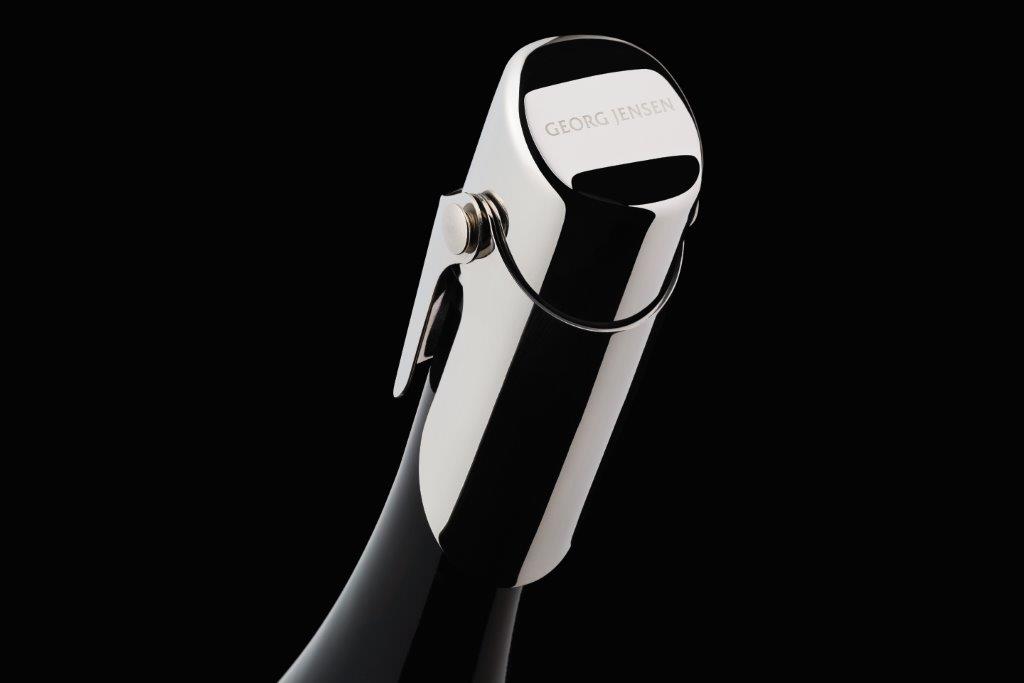The bottle is sleek and elegant, suggesting the sparkling wine inside will be worth drinking. Yet a great many bottles are beautiful. And, unfortunately, when it comes to premium Australian wine, a great bottle isn’t enough.
But one look at the stopper, and it’s clear that the Heemskerk Georg Jensen Hallmark NV Cuvée is different.
The problem
Australian sparkling wine has never been better, particularly if it’s from Tasmania. Although many people think of Australia as a hot country, Tasmania – the island at the bottom of the continent – not only has a moderate maritime climate, but is the gateway to the Antarctic. Temperatures rarely rise above 24°C, and thanks to its mild summers and long autumns, Pinot Noir and Chardonnay thrive. Since the turn of the century, Tasmania has attracted Australia’s top sparkling winemaking talent, and their wines have won multiple accolades, trophies and critical acclaim.
But over the same period, Australia experienced a commodity boom. Its currency, the dollar, became so strong that by 2011, one Aussie dollar brought US$1.10. Imported wines, suddenly cheaper than domestic wines, flooded into the country, cutting a swathe through Australian wine in general. In particular, local consumers found that Champagne was more affordable than premium Australian sparkling.
The exchange rate problem made life particularly difficult for wines like Heemskerk, a Tasmanian brand with a checkered history. The original Heemskerk vineyard was founded in 1975, but passed from one owner after another, from Roederer to Pipers Brook Vineyard, before landing at direct marketing specialist Cellarmaster Wines. Treasury Wine Estates (TWE) acquired it when they bought Cellarmasters and in the past half decade have worked to revive Heemskerk Wines. But high-quality Australian sparkling wines will always be relatively expensive, putting them head-to-head with Champagne.
Enter Rowena Curlewis, co-founder of Denomination, a Sydney design agency that specialises in drinks.
The design approach
“We had a really interesting brief from the client, Heemskerk Wines,” says Curlewis. “They wanted us to come up with a wine that would change the paradigm of sparkling wine – to give consumers an option that would cross boundaries. A beautiful quality wine that would have a European feel.”
Curlewis says that she and her team keep an eye on global trends that are happening outside of the wine category. “One of the things we’d picked up on a while ago was that partnerships were happening between likeminded brands, particularly in luxury, and we thought that was an interesting idea that hadn’t been applied to wine.”
The team also asked themselves what problem consumers had with sparkling wine that needed to be overcome. “One of the key things with sparkling wine is to keep the contents of the bottle fresh,” says Curlewis. Once they realised that, the solution presented itself. “While there had been some special promotional offers where consumers had been given a stopper, ours was the first one to make the stopper an intrinsic part of the offer.”
Give the wine a special stopper. It sounded good in theory, but only if a stopper could be designed that met the rest of the client’s brief: the final product had to be ‘black dress, sophisticated and minimal’. To realise the vision, Denomination needed to find a luxury, prestige partner who was not only willing to work with them, but whose aesthetic matched the brief. Georg Jensen, the Danish design firm renowned for its silverware, seemed the ideal partner.
“The reason we chose Georg Jensen is the Heemskerk brand has European bottles and the colour palette is all silver, and the Georg Jensen range complemented that,” explains Curlewis. “They have the same organic lines and specialise in silver. The second thing is that Georg Jensen’s design philosophy values practicality and beauty.”
Heemskerk Wines loved the idea, but there was a hurdle to overcome – getting Georg Jensen to agree to the proposition. Curlewis put together a case study to explain Heemskerk and its target market and its positioning. Curlewis made a point of saying that their design had been heavily influenced by Georg Jensen’s aesthetic.
Georg Jensen’s response? “They loved the design.”
But how did an Australian wine design company come to be pitching to a Danish design company? Where did they even begin to find the right contacts?
“Google,” says Curlewis. “We found the most appropriate person to contact, wrote an email, put everything together in PowerPoint to demonstrate our case, and followed up.” She says the case study made it abundantly clear that Denomination thoroughly understood Georg Jensen’s brand. Once the Danes agreed, they were put in touch with Heemskerk, to work out the behind-the-scenes contracts.
“We shared our technical drawings,” says Curlewis. “Georg Jensen were fantastic, especially from a technical perspective, and made some minor suggestions.” Denomination found a supplier to make the stopper that both they and Georg Jensen were happy with, and a prototype was created.
The wine itself was a special production cuvée. To create an NV wine with a lower price point – about A$40.00 ($30.50) – Heemskerk used some cool climate grapes from outside Tasmania. The new wine was launched at the Sydney Opera House in November 2015, five months after the project began. “The bottles were imported from Italy, the stopper came from China, and we had numerous stakeholders involved,” says Curlewis, “but this is a very important project for Heemskerk and everyone pulled out the stops.”
Instead of launching solely to wine media, the invitation list was split between traditional media – including fashion magazines – and social media influencers, particularly fashion bloggers. Between them, they talked up a storm.
“The take up was honestly incredible,” says Curlewis. “Word of mouth through social media went wild and the wine was difficult to get. You’d get a pallet into a store and it would be sold out within an hour and they’d be screaming for more pallets.” In fact, she says, Heemskerk had to delay an advertising campaign they had planned, because sales were so high that there wasn’t enough wine to keep up with demand.
But, Curlewis says, more wine is on the way.
Wine first
And what about the wine? If that’s no good, then the stopper is just a gimmick. But ratings across multiple platforms were high, with critics and consumers alike giving the wine scores above 93 points.
Curlewis has a deep knowledge of wine and says that when she and Margaret Nolan founded Denomination in 2002, they decided from the start they were going to stick to drinks. “A lot of agencies make the mistake of being a jack-of-all-trades,” she says. “But wine is an industry that’s very complex and requires a lot of knowledge to do well: consumers, regions, varietals, etc. You can’t snap in and do it. It’s an industry that’s like no other.”
Another mistake that design agencies make, she says, is having a house style, so they leave a clear stamp of their own on everything they do, rather than amplifying the client’s personality. Denomination’s approach has clearly worked for them, as they opened a London office in 2014, and have a client list that stretches from Australia to Champagne and Rioja.
So what’s next for Heemskerk? In the future the agency may think of a new stopper, to keep interest high, but at the moment there’s no end in sight for the demand.
This article first appeared in Issue 4, 2016 of Meininger’s Wine Business International




